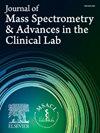基于mrm的LC-MS方法用于c肽的准确定量
IF 3.4
4区 医学
Q2 MEDICAL LABORATORY TECHNOLOGY
Journal of Mass Spectrometry and Advances in the Clinical Lab
Pub Date : 2025-02-12
DOI:10.1016/j.jmsacl.2025.02.001
引用次数: 0
摘要
c肽分泌反映了β细胞的功能,已成为糖尿病的一种有价值的临床生物标志物。c肽测量可以提供胰岛素分泌能力的估计,帮助临床决策和区分糖尿病类型。不幸的是,c肽检测仍然没有标准化,这可能限制了它们的实际临床应用。我们开发了一种基于mrm的LC-MS方法,其精度接近我们的参考方法。目的建立并验证c肽的质谱测定方法。方法用同位素标记的c肽加标法测定血清样品。富集过程包括甲醇沉淀蛋白质、固相萃取、阴离子交换富集c肽,然后进行Glu-C消化。LGGGPGAGSLQPLALE肽在正离子模式下用MRM定量。校准过程包括c肽CRM材料,确保测量有完整的可追溯链。结果该方法在较宽的c肽浓度范围内呈线性,定量限为0.058 nmol/L。日间不精密度小于9.6% CV,日间不精密度小于8.9% CV。与胆红素、甘油三酯和血红蛋白一起注射没有干扰,除非甘油三酯水平很高。该方法与c肽参考方法具有较强的相关性(r2 = 0.95)。结论建立的质谱分析方法对c肽的定量结果准确,可作为现有c肽参比法的补充。这确保了随着时间的推移持续稳定,并最终完善了现有的参考系统。本文章由计算机程序翻译,如有差异,请以英文原文为准。
MRM-based LC-MS method for accurate C-peptide quantitation
Introduction
C-peptide secretion mirrors beta-cell function and has emerged as a valuable clinical biomarker for diabetes mellitus. C-peptide measurements can provide estimates of insulin secretory capacity, aiding in clinical decision-making and differentiation between diabetes types. Unfortunately, C-peptide assays are still not standardized, which may limit their practical clinical use. We have developed an MRM-based LC-MS method that demonstrated accuracy close to our reference method.
Objective
To develop and validate a mass spectrometry method for accurate quantitation of C-peptide.
Method
A serum sample was spiked with isotope-labeled C-peptide as a standard. The enrichment process involved protein precipitation with methanol, solid-phase extraction, and anion exchange for C-peptide enrichment followed by Glu-C digestion. The peptide LGGGPGAGSLQPLALE was quantitated using MRM in positive ion mode. The calibration process includes C-peptide CRM material to ensure a complete traceability chain for the measurement.
Results
The assay exhibited linearity across a wide range of C-peptide concentrations and a limit of quantitation of 0.058 nmol/L. The inter-day imprecision was less than 9.6 % CV, and the intra-day imprecision was less than 8.9 % CV. Spiking with bilirubin, triglycerides, and hemoglobin demonstrated no interference, except for triglycerides at very high levels. The method exhibited a strong correlation to the C-peptide reference method (r2 = 0.95).
Conclusion
The developed mass spectrometry method has demonstrated accurate results in C-peptide quantitation and can serve as a supplemental method to the existing C-peptide reference method. This ensures sustained stability over time and ultimately refines the existing reference system.
求助全文
通过发布文献求助,成功后即可免费获取论文全文。
去求助
来源期刊

Journal of Mass Spectrometry and Advances in the Clinical Lab
Health Professions-Medical Laboratory Technology
CiteScore
4.30
自引率
18.20%
发文量
41
审稿时长
81 days
 求助内容:
求助内容: 应助结果提醒方式:
应助结果提醒方式:


